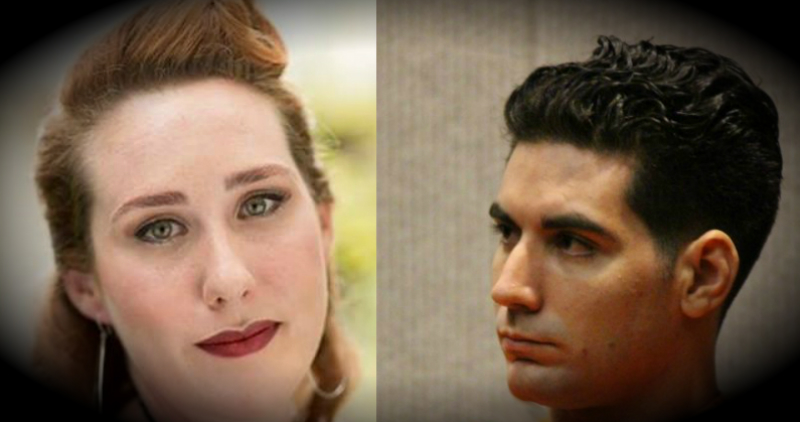Capobianco Trial: Defense Witness Says Injuries Point to Wild Boar

Steven Capobianco (6.29.16) Photo by Wendy Osher.
The murder trial for Steven Capobianco resumed last Thursday, Nov. 10, with a full day of testimony from defense witness Dr. Michael Laufer.
Laufer disputed expert testimony presented by the prosecution relating to jawbone injuries and blood stain patterns on jeans.
He offered an opinion saying marks left on the jawbone recovered from Nuaʻailua in East Maui, were from a four legged creature, possibly a wild boar weighing 150-200 pounds or more. That’s contrary to testimony from a prosecution witness who had said marks were consistent with a serrated edge knife and defleshing of the bone.
Capobianco is standing trial for the murder of his pregnant ex-girlfriend, Carly “Charli” Scott and for setting her vehicle on fire in February of 2014. He has pleaded not guilty to the charges.
Training/Experience: Dr. Laufer is an emergency physician and trauma surgeon, in addition to a developer of medical devices and a venture capitalist. As a trauma surgeon, Laufer said he deals with everything from immediate care and stabilization of a patient to taking them to the operating room and fixing whatever injuries they have. Laufer said he mostly works at Stanford University, but is currently on leave due to personal surgery, and plans to return upon recovery.
Laufer attended undergraduate school at the University of Colorado at Boulder where he started his own major of bioengineering, which didn’t exist at the time. He attended graduate school at Stanford University and did his residency at Harbor UCLA Medical Center with a subsequent fellowship at Stanford.
On cross exam, Laufer confirmed that he has no certification or formal training in forensic pathology or forensic anthropology, but has observed and watched forensic pathologists perform their duties. Prosecutors also asked about the 25 businesses he started and his investment in another 35. Laufer said he sold four, is still involved with 12, and the others have gone public or in some other way have become liquid.
Jawbone: Defleshing of Bone with Knife or Wild Boar Teeth?
The defense showed Laufer photos of a jawbone recovered from Nuaʻailua in East Maui and focused on several linear marks that appeared on the right side of the bone. While a witness for the prosecution said marks were consistent with a serrated edge knife and defleshing of the bone, Laufer said the marks were from a four legged creature, possibly the front incisors of a wild boar.
“Obviously there are a bunch of different marks that were slightly caused by different things, but in general its fair to say they were cased by animal activity as opposed to knives,” Laufer testified.
He pointed to one particular area of the bone and said that it is “highly unlikely” that it was caused by a knife. In explaining his statement, Laufer said, “Knife injuries or knife marks generally don’t occur directly in parallel. They’re off a little bit, either because this is not a flat surface, or for a number of different reasons. So having two parallel edges is very unusual.”
“The two parallel lines look like they’re the edge of a tooth–a single tooth–with the central area being the wide part of the tooth, most likely incisors… and that broad area is mostly natural, but it’s got those little stripes, if you will, going along it, and that’s also probably from just multiple passes of a tooth cleaning off that area because that’s where a lot of the meat is attached if you will,” said Laufer.
Laufer further explained, “If you’re trying to take the tissue off of the bone, you’re usually scraping; you’re not slicing along it, so that’s unusual as well.”
When asked if a fracture to the jaw could have been caused by a punch, Laufer responded saying, “Certainly not from the side, and highly unlikely from the front without causing other fractures at the same time.”
On cross exam, prosecutors asked about an area of the mandible where it appeared that bone was removed, and Laufer responded saying, “a lot of that is actually how it appears naturally because the muscle attaches there. So I don’t think you can say the bone has been removed without also saying that everything connected to the bone is removed.”
The prosecution also asked about “wavy lines” that appear on the right mandible that an earlier witness described as a cut mark that scrapes down. Laufer called the marks “striations,” but said that he didn’t see them “because there’s a tooth mark next to the striations.”
Laufer agreed with the defense that his opinions are to a reasonable degree of medical certainty saying, “That means that nothing’s perfect and you sort of do things to the best of your ability based on your experience and your knowledge.”
Shape of Blood Stain on Blue Jeans: Condom or Handle of Knife?
The witness was asked about a blood stain on the right thigh of a pair of blue jeans recovered as part of the investigation. The witness was informed that the DNA profile on that stain is that of the victim.
Laufer said, “There’s an area of blood, and then there’s an area with no blood. And interestingly enough, there’s an area of blood that sort of goes along the edge of whatever this thing is that kept the blood from touching the jeans in that place.”
“If blood dropped onto the jeans, generally you’d have a blob of blood in this whole area. You wouldn’t have this thing in the middle where there is no blood,” Laufer said.
“Something is masking off the jeans from the blood,” said Laufer. He continued, “This looks like a condom with the reservoir end sort of coming out to there.”
On cross exam, prosecutors asked Laufer if any other figure comes to mind besides a condom and he replied saying, “I scratched my head for a long time trying to figure it out, and it took a while to figure that one out and it just makes perfect sense… I can’t think of anything else that’s that shape.”
Prosecuting attorney Robert Rivera asked, “Can a knife handle cause those lines?” Laufer responded saying, “No.” Rivera asked if he was certain and Laufer said, “I can’t think of any other thing that takes that shape and also excludes the blood from the area. It has to be something that actually sticks to the fabric and keeps the blood from soaking in under it.”
Rivera noted that there are some blood-like stains in the area and Laufer replied, “I think I see what you are referring to, but for the purposes of what I’m talking about, in my opinion, the blood is excluded from that area–not completely because there are a couple of other spots, but it’s obvious that there’s no blood in an area that’s shaped.” He continued saying, “The point is there is a large excluded area even though there might be a few speckles of blood inside the area.”
During defense questioning, Laufer said, “When you see clothing that’s worn in the commission of a bleeding event–murder, assault, battery, etc.–and people get blood on their hands, their hands usually go to various places, and those places are most commonly around the pockets. So any of us who have fixed a car or whatever and have grease on our hands, you know there would be grease around the pockets too because that’s the common place for the hands to go. And there’s no blood around the pockets,” said Laufer.
On cross exam, prosecutors questioned Laufer about the use of gloves and asked if someone using gloves would put their hands in or around their pockets in the same way.
Blue Jeans: Who Wore Them?
When asked if he had an opinion on what sex the person was who wore the jeans, Laufer referenced the position of the button and said it was consistent with being a pair of male jeans.
When asked about the wear pattern on the clothing, Laufer said, “It’s kind of curious. Usually in jeans, especially if you’ve worn them enough, to get these crease marks on both lateral sides of the leg, you would expect the crease marks around the crotch as well, and there aren’t any,” said Laufer.
By the label, the jeans are 32 waist x 30 length, which typically would fit somebody who was 5’9″ to 5’10”. “What’s interesting is that the bottom of these jeans are sort of ragged from being stepped on by the shoes, and so it suggests that whoever was wearing these jeans was shorter than having an inseam of 30 inches.”
Laufer also testified that how you wear your jeans is important. If worn really low, the wear for an individual’s knees would be at a different place. Laufer said that with wrinkles and wear in the middle portion of the leg, it suggested that the garment was worn with the waistband above the hips.
On cross exam, prosecutors showed a photo of the defendant wearing his pants down low, positioned blow his waist and asked if that could have caused the wear found on the bottom of the pant leg.
How Much Blood is Present on Blue Jeans
Laufer described the amount of blood on the blue jeans as saying “It’s not a whole lot of blood.”
“The stain on the left that we’re looking at now on the back of the jean, is less than 4 or 5 cc’s of blood. The stain that was on the right front is at most 8 to 10 cc’s of blood. If you were talking about someone who was stabbed, you would expect liters of blood, so thousands of cc’s of blood, and there’d be a lot more than what we’re seeing here,” said Laufer.
In earlier testimony, witnesses testified that Scott had a condition called placenta previa.
Laufer said that a fetus of 20-21 weeks has between 150 to 200 cc’s of blood, “so if all the blood comes out, you’d might see as much as 150 to 200 cc’s. Usually, when there’s a [placenta] previa, if we get the bleeding stopped, you’ll loose 20 to 30 cc’s of blood.” When asked if the condition could be fatal, Laufer responded saying, “For the fetus, for sure. For the mother, the biggest cause of morbidity and mortality is from infection.”
Black Jeans: Confusion over Male or Female Garment
Laufer was also show a pair of black jeans that were recovered from Nuaʻailua. He noted that the jeans were the same size as the blue jeans that were presented as evidence in the case.
On cross exam, prosecutors asked Laufer, “Before coming to court today Dr. Laufer, was it your belief that the button portion on the black pair of jeans was on the left side, therefore you concluded that was a woman’s jeans?” Laufer responded saying, “I looked at them and it looked as though the snap was on the other side, yes.” Prosecuting attorney Robert Rivera followed up saying, “You realize today though you were mistaken about that, right?” Laufer replied saying, “Well, I saw two pictures today and it looked like they were both on the right side.”
Rivera followed up asking, “But before you saw those pictures, you were of the opinion that those were ladies jeans because the button was on the left side, is that correct?” Laufer said, “Before I observed the jeans yesterday, I was of the opinion that they were both on the right side. It was only after I saw the jeans yesterday, that changed my view. And then I saw the pictures again today and I said okay fine, I just must have mis-seen them yesterday.”
Rivera continued to question Laufer saying, “This morning, didn’t you tell us when we met with you that you thought the black pair of jeans, the button was on the left side, therefore it’s a pair of female jeans?” Laufer responded, “Yes, and that was from after seeing them yesterday.”
Rivera then asked, “So, did you make a mistake yesterday when you thought it was on the left side?” Laufer responded saying, “I thought they looked like they were on the left side and then I saw pictures today and they looked like they were on the right side.”
Rivera asked, “You now agree that the pair of black jeans, the buttons are on the right side, again that’s a pair of male jeans?” Laufer confirmed saying, “Correct.”
Payment/Compensation
When the prosecution asked how much he was being paid to testify, Laufer replied saying he was not getting paid, but was being compensated for his time. After spending an estimated 40 hours on the case, he said the amount would be $10,000, but said it is much less than what he would be making otherwise if he was at home.
The trial is set to resume on Tuesday, Nov. 22 to accommodate scheduling that was previously approved by the court.
The defense had only planned on two days worth of testimony, but has not yet rested its case. Closing arguments have not officially been set by the court yet.

Charli Scott (left) courtesy photo; Steven Capobianco (right) by Wendy Osher (May 2016).
Case History/Background:
Steven Capobianco is standing trial for the murder of his pregnant ex-girlfriend, Carly “Charli” Scott. He is also accused of setting her vehicle on fire.
Scott was 27-years-old and five months pregnant at the time with an unborn child fathered by the defendant. Capobianco has pleaded not guilty to the charges.
In the days following Charli Scott’s disappearance, Capobianco had done an interview with police in which he said Scott had picked him up on the night of Sunday, Feb. 9, 2014, and dropped him off at his truck that he said got stuck in Keʻanae on Feb. 8, 2014.
According to the account, both headed back to Haʻikū, with Scott following Capobianco in case his vehicle broke down again. Scott was reported missing the next night on Feb. 10, 2014, after she failed to show up for work and did not return phone calls and messages from her family members.







